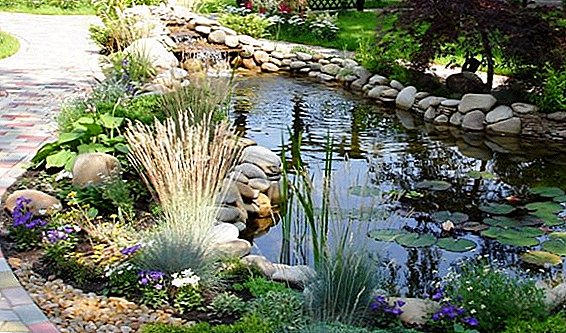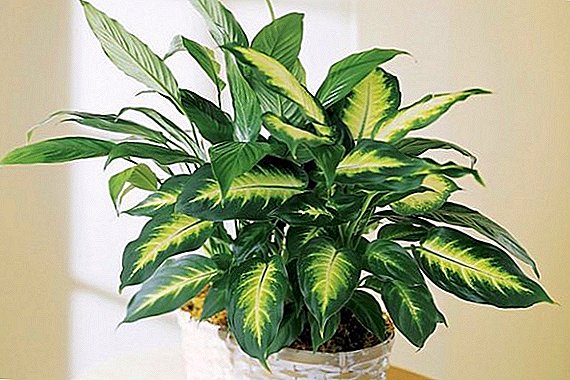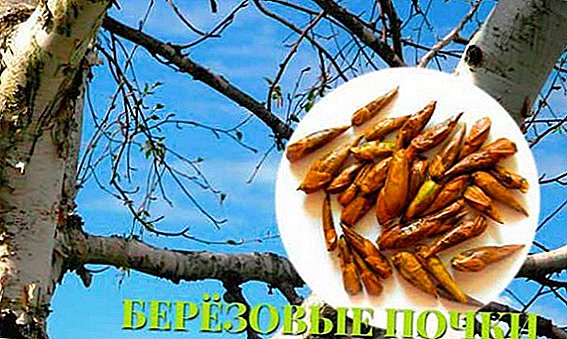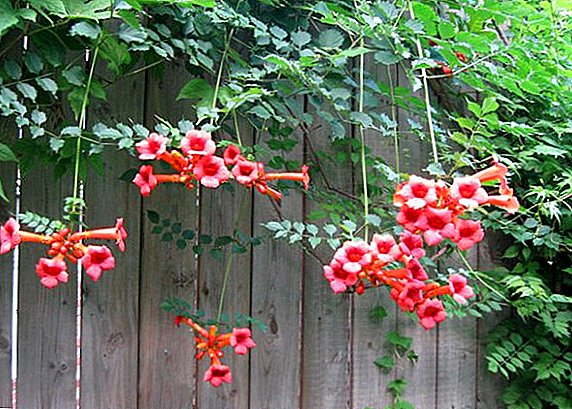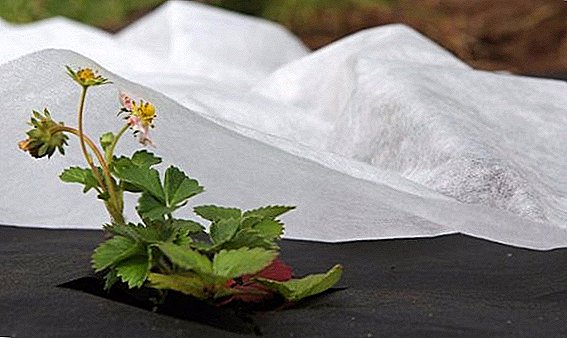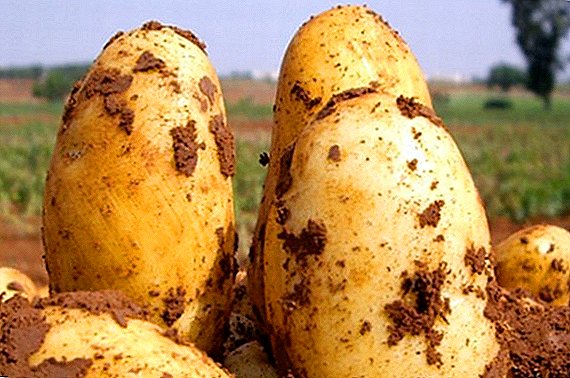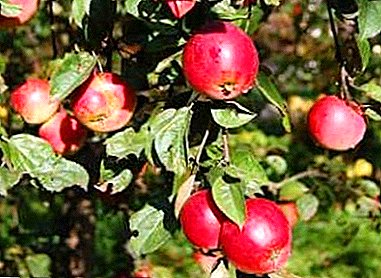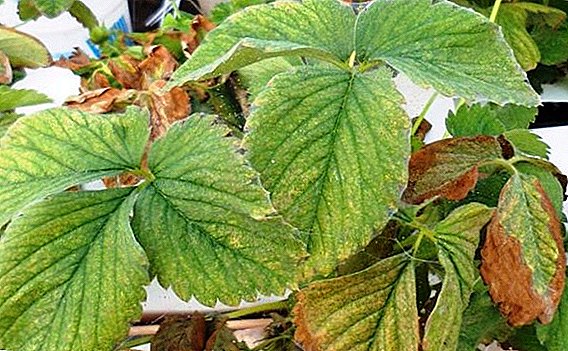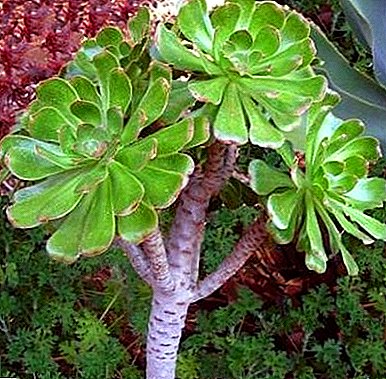
Growing indoor plants for many years remains a popular occupation among city hostesses. Previously, window sills liked to decorate with violets, aloe, geraniums, begonias. Today come into fashion exotic southern plantssuch as eonium. They attract the attention of simple care, unusual decorative appearance, beautiful and rare flowering.
Origin
Its name comes from the Latin word "Aeonium" (eternal, alive). Sometimes it is called "Desert Rose".
The place of growth is Canary Islands. It is also found in some parts of Ethiopia and the Mediterranean, on the Arabian Peninsula.
Characteristic appearance
Eonium - genus of succulent plants from the family Endowed with characteristic features that distinguish it from other plant species.
- Tree trunk, branching, erect, brown. Branches are curved.
- The leaves are fleshy, leathery, gathered in dense rosettes on the tops of the stems. There are species with green leaves and burgundy (Atropurpureum), which require good solar lighting to maintain color.
- The root system is powerful enough, but vulnerable to decay. In many species, the formation of additional aerial roots is possible.
- Flowers of different shades: white, red, yellow. Formed on a long, thick pedicel. The inflorescences are large, umbrella.
Kinds

In nature, there are about forty species. We will consider the most popular ones:
Aeonium Layered
Synonyms: cymbal, longline. Compact succulent flower with a green, flat, sessile, cymbal rosette of leaves, up to 50 cm in diameter. In the upper part they are extended and spatulate, and narrowed towards the base. The edges are bordered with thin blond hairs. The socket is very tight. The position of the leaves in it resembles a tiled roof. The flowers are yellow. The inflorescence is umbrella, pyramidal. Seeds are dark, small. After flowering and fruiting dies. In nature, found on Tenerife.
Aeonium Wavy
Large succulent flower with a large, low-branched stem, silver-gray color and brownish scars. The socket is dense, with a diameter of up to 30 cm. The leaves are dark green, shiny, rounded, wide and spatulate. In the upper part widened, narrowed to the base. Wavy edges. The inflorescence is broad-pyramidal. The flowers are small, lemon.
Eonium Home
Compact heavily branching shrub 25-30 cm tall. Tree trunk. From the base, prostrate branches are formed, curving near the top. The leaves are small, covered with fibers. Inflorescence large. The flowers are yellow. The view is often used to create green mini-aquariums, design compositions. It has aesthetic, decorative qualities, perfect for the role of the main tall element. The origin of the species remains a mystery. Some botanists consider it a garden hybrid.
Aeonium Variegata

It belongs to the subspecies of Home. Differs in light specks on leaves. Often grown in large exotic greenhouses.
Eonium Treelike
Low branched shrub with erect stem and succulent leaves. Stems 2-3 cm in diameter. Young leaves tightly pressed. The surface is shiny, smooth. Flowers are yellow, appear in February. Delivered from Morocco.
Aeonium Haworth
Tall, highly branchy shrub. Lateral thin branches are formed immediately under the socket. Over time, they become more rigid, aerial roots appear. Leaves are dense, ovate, gray-green, with a red stripe, cilia along serrated edges. Socket loose. The flowers are small, yellow with a pink tinge. Some growers compare adult shrubs with bonsai.
Aeonium of canary
Succulent with a shortened stem and a large, spectacular rosette of leaves up to 45-50 cm in diameter. Young leaves are bright green, slightly pubescent, pinkish. Peduncle long, up to a meter in length. Lemon flowers. Differs in balsamic aroma of leaves.
Aeonium lindley
Perennial compact shrub with stem woody at the base, up to 30 cm in height. The branches are numerous, brown, thin. The leaves are small, spatulate, green, covered with hairs. When touched, they slightly stick to the surface of the hands. Flowers are golden yellow, clustered in racemes. Caring at home for Eonium Lindley is similar to other species. In greenhouses and apartment is kept in warm conditions. Resistant to growing in rooms with artificial lighting. Propagated shoots with 2-3 rosettes of leaves. It is worth noting that Lindley shoots take root very well in the water. Attention florist! In hydroponic culture, the plant grows well on LTA-2 solution. The view is often chosen by designers to create flower arrangements, mini-aquariums.
Aeonium Decorative

Shrub hemispherical shape. The leaves are fleshy, small, slightly jagged at the edges, shiny, green with red edges, gathered in beautiful flat rosettes formed at the ends of branched shoots. Pink flowers. Inflorescence racemes. It blooms in May and July.
Eonium Treelike Schwarzkopf
Popular in floriculture. Subspecies of the Tree. It is characterized by dark, red-maroon leaves.
Care for eonium at home
Growing a plant is not difficult. It is enough to follow simple recommendations.
After the purchase
Many housewives get the flower is not thought out. Someone buys by chance at an exhibition, supermarket, shopping center, or maybe just gets it as a birthday present. As a result, the pot is left on the windowsill and begin to care for him. It is not right. Immediately after purchase, the plant must be transplanted! The substrate and the container in which it was located in the store are not suitable for permanent cultivation and are used only for temporary overexposure.
Choosing a pot
The root system of the plant is powerful, so the capacity is suitable high and not wide. It is better to give preference to ceramics rather than plastic. Be sure to have a hole at the bottom.
Soil selection

The substrate needs a light, porous, well-permeable to oxygen and moisture to the roots. You can make the soil yourself by mixing the leaf and grain ground in equal parts. Add peat, sand, brick chips.
Planting flower
- Rinse and disinfect new container thoroughly.
- Make a drainage layer and fill the ground.
- Place the plant in a moist substrate and lightly tamp the soil.
Lighting
The room should be well lit. The optimal place in the house - window sills, facing the south, south-west, south-east side.
- On hot days, make a light shade from the sun to prevent burns on the leaves.
- The flower does not tolerate a slight darkening. But, in some species, the characteristic bright color of the leaves appears only in the sun.
- In winter, take care of an additional light source (if required).
Watering

In the summer and spring, you need to water regularly (about 1 time in 7 days). On hot days more often. In winter, watering is practically suspended.
Attention! Eonium is sensitive to excess moisture. Stagnant water can cause decay.
Air humidity
Additional moisture is not required. Sometimes you can spray with water to remove dust. Some growers cover the soil with cellophane during spraying to prevent water from entering the substrate.
Top dressing
From May to August, fertilizers are applied once every 30 days.
Use liquid fertilizer for succulents and cacti that contain a lot of potassium.
It is recommended to take a dose half the required one. An excess of minerals can be harmful to health. The variegated species are covered with light spots.
Temperature conditions
In spring and summer suitable moderate, warm temperature - 20-25 degrees. In winter - about 14-15 degrees.
Keep away from cold winds, drafts and sudden changes in temperature.
In good weather, you can take the pot outside so that the plant is ventilated and breathed fresh air.
Breeding
Eonium propagates with the help of leaf cuttings, apical rosettes, stem cuttings, seeds.
- Leaves and rosettes make it the easiest thing. It is enough to stick them in the substrate (sheet 1/3)
- The cuttings are rooted in the sand under polyethylene, having processed the cut with phytohormone. Rooted cuttings are planted in separate containers and placed in ambient light conditions.
- Can be propagated by seed. For E. Tarelchaty is the only way to save life. They are sown at the end of winter in a mixture of leafy earth and sand. Above a little sprinkled with earth. Germinated at a temperature of 12-14 degrees. After 1-2 weeks, the first shoots will appear.
Bloom
In the home culture eonium blooms rarely, but very beautiful and long-lasting. After this, the shoot bearing the flower bearing dies off. E. The plate-shaped stem has a non-branching stem and a single plate, therefore it dies after flowering. Flowering time may vary and depend on the specific type.
Smell

The flower has no pronounced smell. The leaves of some species (E. Canary, E. Lindley) are distinguished by balsamic aroma.
Lifetime
May vary by species. Aeonium refers to perennial flowers.
Pests, diseases
Eonium has a good immune system, resistant to diseases and pests. Problems may occur with inadequate care.
- Stagnation of moisture leads to the appearance of rot. It is important to detect the disease in time, and transplant the flower into a new container and substrate. Roots thoroughly washed, cleaned and treated with a weak solution of potassium permanganate. As a preventive measure, follow the recommended irrigation regimen.
- With a lack of light, the stems are drawn out, the sockets become loose, the leaves fall. It is important to rearrange the pot in good lighting conditions.
- Fungal diseases are manifested by the appearance of brown, yellow spots on the leaves. The treatment with special preparations, the establishment of irrigation regime, transplanting if necessary.
- Sometimes the plant infects a mealy worm. It can be seen on a white wax coating resembling cotton wool. An effective way to deal with soap suds or a cotton swab. After that you can spray with infusion of garlic or green soap. With severe infection, karbofos is used.
Therapeutic properties of éonium
Sometimes eonium is used in traditional medicine.
- The juice of the leaves is used to treat glaucoma, herpes, burns. It has antibacterial properties, promotes tissue regeneration. Women add juice to cosmetics to get rid of wrinkles, rejuvenate the skin.
- Oil has antiseptic properties. It is used to treat inflammation, wound healing, with an allergic rash.
Nowadays aeonium is popular among many gardeners. It attracts the attention of an unusual, exotic, decorative look. He will be able to decorate any home interior, be used to create flower arrangements or green mini-aquariums. Care for him is not difficult. If you give him your care and attention, for a long time he will delight you and create comfort in the house.
A photo







